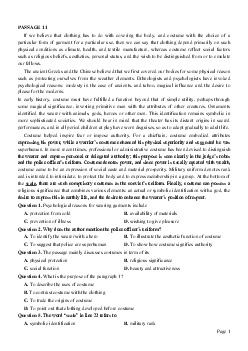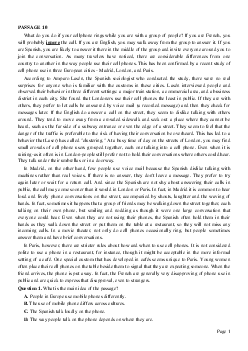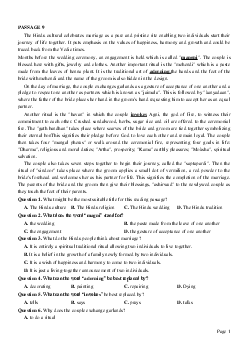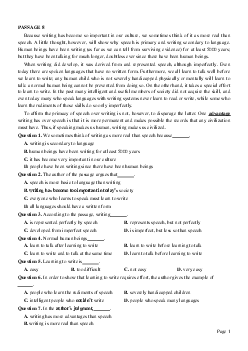


Preview text:
PASSAGE 3
Read the following passage and mark the letter A, B, C, or D on your answer sheet to indicate the
correct answer to each of the questions from 1 to 8.
For many people, mushroom are strange, colorless, incomprehensible plants that should be avoided.
Quaint tales and scary stories surround mushrooms become some are extremely poisonous. In reality,
however, mushrooms are fungi that are simple plants without developed roots, leaves, stems, flowers, or
seeds. They grow in wetlands, grassy meadows, and woods. Certain types of mushrooms are delicious
and are included as ingredients in many recipes and trendy snacks. For example, morels are considered
one of the choicest foods, and truffles, related to morels, are highly prized in Europe. Their shape is tube-
like, and they remain entirely underground, a foot or more below the surface. In the old days, dogs and
pigs were specially trained to hunt them by scent.
Mushrooms stand out among other plants because they have no chlorophyll and cannot generate
their own nourishment. The part of the fungus that rises above the ground is the fruiting body, and the
vegetative part that produces growth is hidden under the ground. It can be usually dug up in the form of
dense, white tangled filaments, which, depending on the food supply and moisture, can live for hundreds
of years. In fact, mushrooms, as well as the rest of the fungus genus species, are one of the few remaining
simple plants that are believed to be among the oldest living organisms. When their environment is not
conductive to growth, filaments stop proliferating and can lie dormant for dozens of years.
Although mushrooms are rich in flavor and texture, they have little food value. Picking mushrooms
requires a thorough knowledge of environments where they are most likely to grow and an ability to tell
between edible and poisonous plants. Most mushrooms thrive in temperatures from 680 to 860 (F) with
plenty of moisture, and nearly complete darkness produces the best crop. The entire mushroom should be
picked, the stem, the cap, and whatever part that is underground. Brightly colored mushroom caps usually
indicate that the plant is not fit for consumption, and the more the mushroom attracts attention, the more
poisonous it is. Mushrooms with beautiful red or orange spotted caps that grow under large trees after a
good rain are particularly poisonous. If milky or white juices seep from a break in the body of plant,
chances are it should not be picked. Old mushrooms with brown caps are also not very safe.
Question 1. The word “quaint” is closest in meaning to A. convoluted B. fanciful C. irritating D. perfunctory
Question 2. The word “trendy” is closest meaning to A. tender B. experimental C. fashionable D. trusted
Question 3. With which of the following statements is the author of the passage most likely to agree?
A. In the old days, when the food was scarce, people chose mushrooms as food.
B. Mushrooms should be treated as all other plants.
C. Because they are poisonous, people should stay away from mushrooms.
D. Mushrooms have different forms of roots, stems, and leaves.
Question 4. It can be inferred from the passage that mushrooms multiply mostly by means of A. moisture B. fruiting bodies C. nourishment D. root systems
Question 5. The word “Their” refers to A. morels B. foods C. truffles D. morels and truffles Page 1
Question 6. The word “tell” is closest in meaning to A. narrate B. distinguish C. say D. see
Question 7. What does the author of the passage imply about brightly colored mushrooms? A. They are beautiful.
B. They should not be eaten.
C. They attract attention.
D. They should be destroyed.
Question 8. The author of the passage implies that mushrooms
A. have been known since ancient times
B. are a relatively recent form of plants
C. cannot survive without a good environment
D. have been carefully analyzed ĐÁP ÁN 1-B 2-C 3-B 4-D 5-C 6-B 7-B 8-A
LỜI GIẢI CHI TIẾT Question 1: B
B: quaint = fanciful (a) cổ xưa và lạ lạ hay hay; A – (a) quấn, xoắn (thực vật); C – (a) gây khó chịu; gây
bực tức; D – (a) qua loa, đại khái, cho có lệ; Question 2: C
C: trend (n) xu hướng; trendy (a) theo xu hướng = fashionable (a) hợp với xu hướng, hợp với trào lưu; các
đáp án khác đều có nghĩa không phù hợp: tender (a) mềm (thịt); B – dựa trên thí nghiệm, thực nghiệm; D – được tin cậy Question 3: B
B: câu này hỏi: câu nào trong số những câu sau đây tác giả của bài đọc đồng ý/ủng hộ nhiều nhất?
Thông tin trong bài “Quaint tales and scary stories surround mushrooms become some are extremely
poisonous. In reality, however, mushrooms are fungi that are simple plants without developed roots,
leaves, stems, flowers, or seeds. – những câu chuyện lạ kì bí và những truyện đáng sợ về nấm biến nấm
trở thành những thứ cực độc. Tuy nhiên, trên thực tế, nấm là những nốt sùi – là thực vật đơn giản không
có rễ, lá, thân, hoa và hạt phát triển” → như vậy qua ý này tác giả muốn thể hiện rằng B: nấm nên được
đối xử như tất cả các loài thực vật khác. Question 4: D
D: câu hỏi “có thể suy ra từ đoạn bài đọc là nấm nhân lên/phát triển chủ yếu bằng …”
Thông tin trong bài “The part of the fungus that rises above the ground is the fruiting body, and the
vegetative part that produces growth is hidden under the ground” như vậy “the part hidden under the
ground – bộ phận nằm dưới lòng đất” chỉ “root systems – các hệ thống rễ”; A – độ ẩm; B – quả thể (vật
thể có hình quả); C – sự nuôi dưỡng Question 5: C
C: câu trong bài “morels are considered one of the choicest foods, and truffles, related to morels, are
highly prized in Europe. Their shape is tubelike,”→ khi phân tích 2 câu này ta thấy: câu thứ nhất đề cập
đến 2 danh từ số nhiều là “morel” và “truffles” – tuy nhiên “truffles” được đề cập sau (gần câu thứ 2 hơn)
nên “their” sẽ phải thay thế cho “truffles” Page 2 Question 6: B
B: tell = distinguish (v) phân biệt, đặt vào ngữ cảnh của câu ta hoàn toàn có thể đoán được nghĩa của từ
“tell”: “tell between edible and poisonous plants – phân biệt giưa thực vật ăn được và thực vật có độc”
Chú ý: có cụm từ sau “tell smb from smb (v) phân biệt ai với ai, vd: I cannot tell Jack from Cody. They
are so alike.- tôi không thể phân biệt được Jack và Cody. Họ giống nhau quá” Question 7: B
B: tác giả ngụ ý gì về nấm có màu sắc sặc sỡ?: thông tin trong bài “Brightly colored mushroom caps
usually indicate that the plant is not fit for consumption, and the more the mushroom attracts attention, the
more poisonous it is. Mushrooms with beautiful red or orange spotted caps that grow under large trees
after a good rain are particularly poisonous” → nấm có màu sắc sặc sỡ sẽ rất đẹp (A); thu hút sự chú ý
(C) và rất độc → đây đều là các ý đã được chỉ ra trong bài → ngụ ý của tác giả là B – chúng ta không nên
ăn chúng; đáp án D – chúng nên bị tiêu diệt (đây không phải là ngụ ý của tác giả) Question 8: A
A: tác giả ngụ ý trong đoạn bài đọc rằng nấm … A – được biết đến từ thời kì cổ đại; B – là dạng thực vật
mới phát triển gần đây; C – không thể tồn tại nếu không có môi trường tốt; D – đã được phân tích kĩ lưỡng
Thông tin trong bài “In fact, mushrooms, as well as the rest of the fungus genus species, are one of the
few remaining simple plants that are believed to be among the oldest living organisms.”→ như vậy, ngụ ý của tác giả là A Page 3




